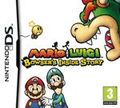You can trust VideoGamer. Our team of gaming experts spend hours testing and reviewing the latest games, to ensure you're reading the most comprehensive guide possible. Rest assured, all imagery and advice is unique and original. Check out how we test and review games here
Have you ever wondered what’s up Bowser’s arse? Who hasn’t? Well, wonder no more, because in Mario & Luigi Bowser’s Inside Story, the third Mario & Luigi role-playing game from Japanese developer AlphaDream, you find out.
Up Bowser’s Arse isn’t a level called “Up Bowser’s Arse”, of course. After all, this is a family-friendly Nintendo game. It’s called “Rump Command” (“Power Space Bottom” in the Japanese version, “Rump Post” in the Spanish and, wonderfully, “Posterior Sanctuary” in the French), and it’s pretty, pretty crazy.
Mario and Luigi find themselves sloshing about Bowser’s greasy innards after the giant Koopa King inhales Princess Peach’s Castle and everyone inside, including the Italian plumbers. Why did Bowser do this? Because the syntax-challenged mad scientist and sensational star of the show, Lord Fawful, tricked him into eating a… “Lucky Shroom”, one that sends him doolally. Okay…
All very Woodstock, huh? Well wait till you get a load of this. In Rump Command, Mario and Luigi meet “Evoglobin”. They’re transcendent spiritual forms – “waves of spirituality spawned us temporary arms and legs”, they tell the moustachioed ones. They want them to save Bowser, their host, after he’s crushed by his own flying castle, now controlled by Fawful. The Evolglobin have been awaiting you “in this sacred place, ever patient”. Right…
So, as you’d expect, Mario and Luigi board “the boats of revival” and ford the “adrenaline channel”. Bowser’s Inside Story then transforms from a 2D side-scrolling platform RPG “thing”, into a vertical “shmup”. The boats of revival are ships, moved left and right with the d-pad, and guns are fired with the A and B buttons. Coloured balls drop from the top of the screen, red for Mario and green for Luigi. They must be fired at by the corresponding ship… sorry, boat of revival, to revive Bowser with adrenaline shots. It’s Ikaruga meets Trauma Centre.
After successfully powering Bowser up with adrenaline, he grows to Godzilla size, and takes on his own castle in a bonkers boss battle which requires the DS be held on its side. With Bowzilla on the left screen and the castle on the right, you need to swipe and touch with the stylus to trigger punches and fire breath as Midbus, one of Fawful’s minions, sends attack after attack at our anti-hero. Looks like Bowser’s not the only one who’s eaten a “Lucky Shroom”.
This is Bowser’s Inside Story: not really an RPG or a platformer, but more a collection of crazy mini-games punctuated by turn and skill-based battles, and tenuously held together by the most psychedelic story in recent memory.
It is a game fans of the previous two Mario & Luigi RPGs, Superstar Saga and Partners in Time, will find instantly familiar. Newcomers, on the other hand, will find it gloriously bizarre and nonsensical. But both will come out the end of the lengthy, 20 hour plus adventure, with smiles on their faces and bellies brutalised by laughter.
The game is divided into two, quite distinct gameplay experiences. On the bottom screen Mario and Luigi explore Bowser’s 2D side-scrolling insides as they attempt to rescue Princess Peach from whatever grisly beasties she might encounter. On the top screen, Bowser punches and stomps his way through the 3/4 overhead-view Mushroom Kingdom as he tries to wrestle control of his castle back from the hilarious Fawful. The game switches between the two regularly, with X and Y controlling Bowser, and A and B controlling Mario and Luigi.
The game’s at its best when Bowser interacts with Mario and Luigi, and vice versa. For example, in one section Bowser can drink to fill his gut with water, which enables Mario and Luigi to swim up to previously unreachable platforms and solve puzzles that riff on the mechanic. Conversely, in some battles, Bowser can inhale his enemies, which then appear on the bottom screen as foes for Mario and Luigi to stomp on.
Most (perhaps too much) of your time, however, will be spent fighting monsters in bog standard turn-based battles triggered by touching enemies as they loiter about the Mushroom Kingdom and inside Bowser’s body. Here, Mario and Luigi, or Bowser, are positioned on the left of the screen, and take it in turns to perform commands you select. Mario and Luigi can jump on their foes, hit them with a hammer, perform special co-op attacks and use items as need be. Bowser can punch, breath fire and use special minion attacks.
Unlike traditional, old school turn-based battles where you input a command then sit back and watch the show, the fights in Bowser’s Inside Story require constant attention and timed button presses. Mario and Luigi’s basic jump attack, for example, can hit twice if you press the button just as you land on the monster. Bowser’s fire breath is a charged attack – press the Y button the millisecond he flashes and it will cause the maximum, “Excellent!”, damage.
There are also defensive and even counter-attack moves. Bowser can punch some enemies as they attack, or defend with his shell. Mario and Luigi can jump to avoid attacks. Each enemy has a “tell” which, if you look closely, gives away its attack pattern and the timing required to avoid or counter it.
The problem, however, is that while you’re always involved, be it in the battles or mini-games or exploration or in the wonderful cutscenes, you never feel truly engaged. The game’s particularly easy, and the RPG elements have no substantial impact on gameplay. Levelling up is inconsequential because the game decides how your statistical increases are allotted. Finding new gear never excites because the boosts they grant aren’t required to win. And the special attacks, gradually gained, are pointless because the use of basic attacks is, most of the time, the quickest way to win. The game lacks strategy and depth so markedly, that the RPG elements need not be there at all.
This, coupled with a stringently linear design that wrestles away any semblance of control over proceedings you may have had, forms an experience that lacks substance, even if it is always great fun. You feel like you’re gliding through the game on auto-pilot, free to enjoy the wind blowing through your hair without worry of turbulence.
The game’s still great, though, in no small part to the wonderful dialogue. Fawful’s incorrect syntax in particular is genuinely funny (“Beef? I am lacking in beef. Fawful is beefless”, and “A WINNER IS YOU!”), and Bowser, for once more than a demented boss, has his moment in the sun and reveals himself to be a likeable, if somewhat single-minded, anti-hero (“Did somebody page the king of awesome?”). The text localisation team has done such a good job, Bowser’s Inside Story will go down as the funniest Mario game of all time.
In truth, this bizarre adventure is tailor made for Nintendo fanboys. It’s packed with in-jokes and Nintendo references that’ll soar above the Brain Training crowd’s head like a Star Powered aeroplane. Its greatest achievement is its pacing: it never loses focus over the course of its 20 hours. It constantly surprises with clever mini-games and stand-out, memorable moments, most of which, it must be said, involve Bowser. But it feels more like a cleverly strung together series of mini-games disguised as a multi-faceted role-playing Mario game, than the multi-faceted role-playing Mario game some might have hoped for. This might be a deliberate concession to accessibility on Nintendo’s part, but it doesn’t sit well with the tone or the plot. The result: you’ll fondly remember exploring Bowser’s colon, but you’ll feel strangely empty when you emerge on the other side.

/https://oimg.videogamer.com/images/ebe5/mario_luigi_rpg_3_8.jpg)
/https://oimg.videogamer.com/images/3b21/mario_luigi_rpg_3_7.jpg)
/https://oimg.videogamer.com/images/3e5f/mario_luigi_rpg_3_4.jpg)






